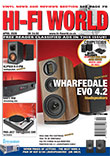USB-to-S/PDIF Convertors |
Page 1 of 7 USB to S/PDIF convertors
From Hi-Fi World - March 2012 issue
Religious Conversion Our review of five USB-to-S/PDIF convertors invokes digital religion, Noel Keywood says. Rafael Todes listens in supplication.
Digital can be confusing at the best of times, and this group of unassuming little convertors demonstrates the issue. Superficially, they convert USB digital audio, typically from a computer, to S/PDIF digital audio suitable for a hi-fi. Their role then is simply to allow a computer to connect to the hi-fi, so music can be played from Windows Media player or iTunes through a decent sound system.
Somewhere along the line, this simplest of ideas got diverted into arcane digital complexity. The digital conversion process has been configured so what could have been simple definitely is not: these units don’t just convert, many of them clean up the digital signal too, in order to lift sound quality. Enter religion!
The group comprises five convertors. ranging in price from the Kingrex UC192 at £159 up to an eye watering £825 for the Audiophilleo 1 – and more expensive designs are available. Budget convertors simply do their stated job, convert from USB to S/PDIF, but as price increases a more sophisticated method of clock control, known as asynchronous operation (see page 25) enters the picture, as well as other interesting ideas such as an external USB power supply and – naturally! – a battery powered external USB power supply.
Yes, it all gets nutty quickly, but that’s what happens to digital audio once audiophile religion takes hold. In this review we keep away from the horrors of Phase Locked Loops and suchlike, and keep it simple. In any case, as intelligent as modern digital circuits are now becoming in their attempts to suppress the ills of digital, the local digital signal chain is so complex and behaviourally difficult to predict, that what actually happens in any one set up cannot be fully known by outside observers.
Digital audio as it comes out of a computer’s USB port is in an entirely different format to that concocted for an S/PDIF connection into a hi-fi system. A USB receiver must assemble the computer audio data, retrieve the clock information, and reduce or eliminate blemishes such as jitter and noise. It is possible to clean up a digital signal using a variety of strategies, often one after another in a daisy chain of digital signal processing, before sending it out to the hi-fi, and both the degree and the sophistication of these strategies is what decides cost.
Whilst most convertors use function-specific silicon chip building blocks, this has difficulties, especially with computer compatibility. Two models, the Halide Bridge and Audiophilleo, use non-function-specific Digital Signal Processors (DSP) in conjunction with an audio framework code, as well as their own custom code, to perform the process and both linked up to Windows Vista (SP2) and Windows 7 immediately in our tests (we did not try XP etc). With the others, a special Windows driver is needed, supplied by the manufacturer. Listening was carried out on Windows 7. Mac OS-X from 10.6 (Snow Leopard) onward works with its own drivers that can handle asynchronous operation. Tests were carried out using OS-X 10.6, so both Windows and Mac were used to check for compatibility.
LISTENING The way digital can degrade sound quality is well known to Rafael Todes, as it affects his recordings of the Allegri String Quartet, in which he plays an Amati violin. In particular, loss of spacial perspectives blurs the placement of players, loss of timbral resolution lessens differences between brass and woodwind, making his Amati sound like a Yamaha synth copy, and digital glare or hardness makes gut strings sound like steel ones. These are all sensitive issues for him so he was keen to listen to these convertors, feeding his Weiss DAC202, a Music First Audio passive preamp., VAC Auricle valve power amp and B&W 802D loudspeakers. Recordings were various but included his own of the Allegri. He listened before we measured and the correlation between what he heard and what we measured is surprising.
* see Conclusion for computer compatibility, asynchronous operation, tests and much more.
|







